(Editor’s note: During the month of April, the Journal presents a series of stories about vintage rallies and vintage racing. But before they were driven in vintage racing events by new owners, cars were brand new and raced for real in the Can-Am and other series. Today, Robert Kolowich, who started racing Formula Fords in the late 1960s, remembers those earlier times. If you have a story about your participation in a vintage rally or race that you’d like to share, please email us at [email protected].)
They say memories are the cushions of one’s life and the Can-Am series was no exception.
I didn’t see all the Can-Am races but only the West Coast swing which were the season ending last two races, at Laguna Seca and Riverside. I do not recall the years held but I remember the first race at Laguna. The series then was called the USRRC, the United States Road Racing Championship.
The race cars were not the more sophisticated missiles they became later. Instead they were cobbled together chassis with a heavy V8 bolted in the back and handled like a pig. That race at Laguna was won by a smaller-displacement car in the rain, which proved a point. Just keep it on the road and don’t spin the tires.
I was racing Formula Ford then and later Formula B/Atlantics. We were a supporting event for the West Coast Can-Am races which everyone wanted to see. Fortunately, I also got to know Red Burmester and driver Tom Dutton, they came out each year with a McLaren M6A/B. Each year they had a bigger and bigger engine ending with an aluminum-block 454 that was huge for that car.
I helped on their crew, which put me right there for all things Can-Am through the years.
The stories from those times that I can tell you are simply racing legend. Some of only a few are the following:
I recall one of the cars was rolled out of the garages at Riverside so as not to have the exhaust fumes engulf everyone. It was to warm up the engine and look for leaks. With the outboard battery connected and the fuel pumps whirling, more fuel was squirted into the tall intake trumpets and the starter engaged. Whoomp! The engine turned over and then was held at a rather low rpm to hold heat. Immediately a swamp of people and cameras surrounded the living beast.
With the mechanic’s hand on the linkage and the thumping exhaust beating on the bystanders clothes, the engine came up to temperature. The crowd had to be at least 10 deep. The sound went right into your bones and you could feel the compression of the air in your lungs and chest. Your whole body and senses were now a part of that thumping motor.
As things were checked for leaks, and found to be okay, the throttle was blipped a few times at higher revs and the ignition cut. The reverence of the gathered crowd let out a combined exhale and the silence was deafening. They all began looking at each other with bug eyes and dispersed. It was as though they had just received holy communion in church.
The tires on those cars were huge and got bigger and bigger each year. I don’t remember the widest they got, but 19 inches was wide. The Goodyear guys worked their tails off changing tires. Those big motors chewed up rubber like it was candy. And the cars held a lot of fuel making them very heavy.
That always freaked me out.
All that gas in that chassis. All that horsepower in the motor. All that speed. Sure there were fuel cells but back then they were not made like today. And they hung out on each side of the car, not like my Formula Ford where the cell was tucked inside. I guess you just turned off that concern as a driver.
We would run the car full of fuel for at least one practice session to see the weight results and adjusted. Then used external pumps to drain the tanks and refuel all our support vehicles.
I got to know all those drivers. Not just the famous ones. This was also the time that sponsorship was starting to emerge. One of them was a cologne called “Roman Brio.” A wonderful graphic across the nose of their car, a big motorhome which few had at the time and pretty girls dressed in near naked outfits.
There was the PRDA, the Polish Racing Driver Association, formed by the late Oscar Kovaleski out of Prussia, Pennsylvania. He was quite the character. I met his daughter in the lounge at the Beverly Hills Hotel a decade later.
I have so many more memories to pass on if you like. Bench racing its called. Andretti, Donohue and Penske. Wonderful times.




I ate, slept, and breathed the Can Am series from 1967 forward. I was young and in the Southwest and never had the opportunity to see a race firsthand. I lived vicariously through Road & Track and Car & Driver magazines. To this day I think the Can Am was the best American racing series ever. Your recollections are fascinating to read. They remind me of what racing can be at it’s best. Please give us more of your “bench racing” stories!
NOTHING BETTER THAN CAN-AM..maybe sprint cars!… maybe?…